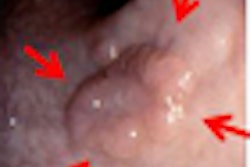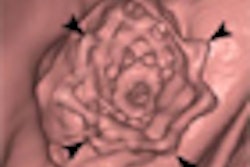When a CT exam is ordered for a child presenting with cervical spine trauma, follow-up radiography adds little to no additional diagnostic information, according to an analysis from the Hospital for Sick Children in Toronto published in the February issue of the American Journal of Roentgenology.
Multidetector-row CT has largely been replacing radiography as the modality of choice for diagnosing cervical spine injuries. But MDCT serves up a much higher radiation dose than x-ray, particularly in children: A 2008 study by Jimenez et al in Pediatric Radiology found that children received as much as 200 times the radiation dose to their thyroid gland with CT compared to radiography, according to pediatric radiologist Dr. Cicero Torres Silva and colleagues (AJR, February 2010, Vol. 194:2, pp. 500-508).
Silva and his team wanted to compare the performance of CT to radiography for evaluating cervical spine trauma in children, and to see if they could improve the performance of lateral-view radiography by adding additional views.
Radiologists evaluated the cervical spine radiographs of 234 pediatric patients who had undergone CT exams ordered by emergency physicians during a six-year time span between January 2000 and December 2005. The radiographs were evaluated for the presence of fractures, subluxations, and dislocations. Any abnormalities were correlated to findings from the corresponding CT examination, which was used as the reference standard.
Twenty-three patients (9.8%) admitted to the emergency department as a result of auto accidents, falls, crush injuries, or sports accidents had positive findings in the reports of their CT exams. By comparison, thirty-three patients (14.1%) had positive findings on lateral-view radiographs.
However, the lateral-view radiograph alone had 73% sensitivity and 92% specificity for cervical spine abnormalities compared with the CT exam. Lateral-view radiographs also missed a significant number of findings; notably, abnormalities involving the posterior arch, the authors reported.
All of the abnormalities that were identified on the lateral-view radiographs were also retrospectively identified on corresponding CT scans.
Medical records showed that the additional cervical spine x-rays changed the interpretation in five patients (2.1% of the total), from negative to positive in four patients and from positive to negative in one patient.
Based on their analysis, the authors believe that lateral-view radiographs showed only a borderline acceptable diagnostic sensitivity for detecting traumatic cervical spine abnormalities, and that the addition of anteroposterior, odontoid, flexicon, oblique, extension, and swimmer's views did not seem to improve diagnostic performance.
They recommended that low-dose CT exams be considered the preferred diagnostic exam for imaging pediatric cervical spine injuries, and in most cases the additional radiation dose exposure of follow-up x-rays to these children can be avoided.
By Cynthia E. Keen
AuntMinnie.com staff writer
February 4, 2010
Related Reading
Studies address need to reduce CT dose in emergency settings, October 17, 2008
Use of pediatric head CT growing steadily in emergency departments, May 4, 2004
Copyright © 2010 AuntMinnie.com



















